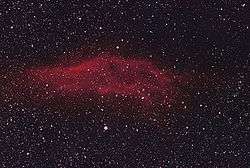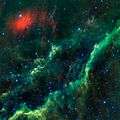California Nebula
The California Nebula (NGC 1499) is an emission nebula located in the constellation Perseus. It is so named because it appears to resemble the outline of the US State of California on long exposure photographs. It is almost 2.5° long on the sky and, because of its very low surface brightness, it is extremely difficult to observe visually. It can be observed with a Hβ filter (isolates the Hβ line at 486 nm) in a rich-field telescope under dark skies.[1] It lies at a distance of about 1,000 light years from Earth. Its fluorescence is due to excitation of the Hβ line in the nebula by the nearby prodigiously energetic O7 star, Xi Persei (also known as Menkib, seen at center below it in the inset at right).[2]
| Emission nebula | |
|---|---|
 The California Nebula, as taken with an amateur telescope | |
| Observation data: J2000.0 epoch | |
| Right ascension | 04h 03m 18.00s |
| Declination | +36° 25′ 18.0″ |
| Distance | 1,000 ly |
| Apparent magnitude (V) | 6.0 |
| Apparent dimensions (V) | 2.5° long |
| Constellation | Perseus |
| Designations | NGC 1499, Sharpless 220 |
The California Nebula was discovered by E. E. Barnard in 1884.
By coincidence, the California Nebula transits in the zenith in central California as the latitude matches the declination of the object.
Gallery
 Image of the California Nebula with amateur telescope.
Image of the California Nebula with amateur telescope.
 H-alpha image of the nebula with amateur telescope.
H-alpha image of the nebula with amateur telescope._narrowband.jpg) Picture of NGC 1499 captured in narrowband by amateur astronomer Luca Moretti
Picture of NGC 1499 captured in narrowband by amateur astronomer Luca Moretti The California Nebula (NGC 1499), in LHaRGB with amateur telescope
The California Nebula (NGC 1499), in LHaRGB with amateur telescope
References
- "The California Nebula". Observing at Skyhound. Retrieved December 23, 2013.
- "Menkib (Xi Persei)". David Darling. Encyclopedia of Science.
External links
| Wikimedia Commons has media related to California Nebula. |